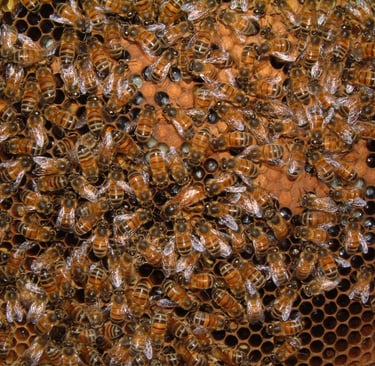Inside the Hive
Understanding Bee Biology, Behavior, and Colony Dynamics


Every successful beekeeper knows that the secret to strong colonies lies in understanding the biology and behavior of the honey bee. From caste roles to communication methods, colony dynamics form the foundation of effective hive management. Mastery of these internal systems allows beekeepers to anticipate problems, boost productivity, and maintain healthy hives year-round.
The Bee Caste System: Division of Labor
Each hive is made up of three types of bees, each with unique roles:
Queen: The sole egg-layer and pheromonal leader.
Workers: Female bees responsible for foraging, nursing, guarding, and cleaning.
Drones: Male bees whose primary role is mating with queens from other hives.
Maintaining balance among these castes is essential. A failing queen or an excess of drones can indicate internal stress. Heliotrope Bee’s gear ensures safe, detailed inspections that support early detection and response.
Life Cycle and Brood Patterns
Understanding the bee life cycle helps beekeepers evaluate colony health. Eggs hatch into larvae, which are fed royal jelly, bee bread, or nectar depending on their destined caste. Brood patterns should be solid and consistent, showing proper queen performance and adequate nutrition.
Spotty brood patterns may signal disease or a failing queen.
Drone-laying workers indicate queenlessness.
Inspections should be performed in lightweight, breathable gear—like ventilated suits and gloves from Heliotrope Bee—for comfort during close, warm-weather work.
Pheromonal Communication and Hive Cohesion
Bees communicate chemically. The queen's pheromones regulate colony behavior, while alarm and foraging pheromones organize tasks. Any disruption—such as queen loss or hive stress—can lead to disarray, aggression, or absconding.
Using calm inspection techniques and protective gear reduces disruption. Heliotrope Bee’s high-visibility suits and flexible gloves allow for gentle, confident handling.
Seasonal Dynamics and Behavioral Shifts
Colony behavior changes with the seasons:
Spring: Explosive brood production and comb building.
Summer: Foraging peaks, and swarming risks increase.
Fall: Resource conservation and queen slimming.
Winter: Cluster formation and reduced movement.
Recognizing these patterns helps plan feeding, treatments, and swarm prevention. Gear from Heliotrope Bee is adapted to seasonal tasks—offering comfort and visibility whether you’re feeding syrup or inspecting brood.
Stress, Disease, and Environmental Feedback
Bee behavior reflects environmental and internal conditions. Beekeepers must interpret signs like:
Bearding (bees clustering outside) as overheating or overcrowding.
Aggression as queen loss, predation, or pesticide exposure.
Low activity as disease, poor weather, or malnutrition.
Heliotrope Bee supports professional management by equipping beekeepers with reliable protective wear to handle sensitive hives in challenging conditions.
Empowered by Knowledge, Protected by Design
Heliotrope Bee has served beekeepers globally since 2012, providing custom apparel for safe, efficient hive management. Understanding colony dynamics is only effective when paired with the right tools—our suits, gloves, and jackets are made to move with you as you decode the language of the hive.
Contact: sales@heliotropebee.com
Explore gear: www.heliotropebee.com


